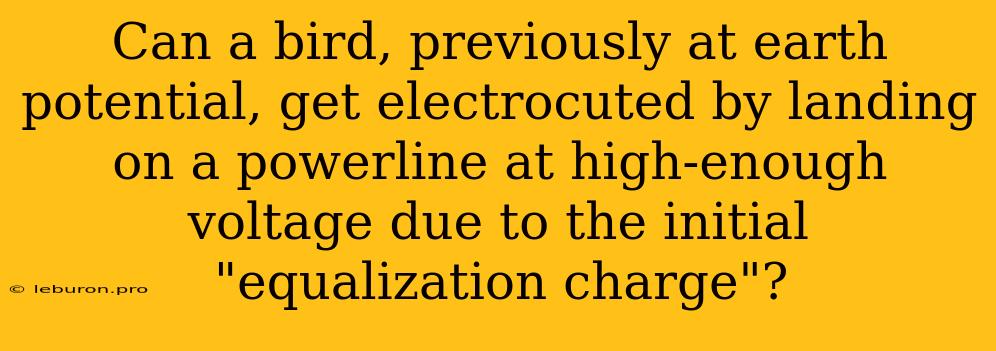The question of whether a bird can be electrocuted by landing on a power line raises an interesting point about the nature of electricity and the potential difference required for a current to flow. While it's true that power lines carry high voltages, the specific scenario of a bird being electrocuted due to an initial "equalization charge" is a complex one, requiring a deeper understanding of the physics involved. Let's explore the factors at play and analyze the likelihood of such an event.
The Importance of Potential Difference
The key principle governing the flow of electricity is potential difference, commonly referred to as voltage. Voltage is the measure of the electrical potential energy difference between two points. For current to flow, there must be a difference in electrical potential between the two points. This difference is what drives the movement of electrons, creating the flow of current.
The Bird's Perspective
Consider a bird perched on a power line. The bird, initially at ground potential, is suddenly brought into close proximity to a conductor carrying a high voltage. This voltage represents a significant difference in potential energy between the bird and the power line. However, it's crucial to understand that electrocution doesn't occur solely due to the presence of voltage. It requires a complete circuit for current to flow through a living organism.
The Circuit: Completing the Path
For electrocution to occur, a path must exist for the current to flow from the high-voltage source (the power line) through the bird and back to a lower potential. In the case of a bird landing on a single power line, this path is unlikely to be formed.
Here's why:
- High Impedance: A bird's body, primarily composed of non-conductive materials like feathers and bone, presents a high impedance to the flow of current. This means it resists the flow of electricity significantly.
- Incomplete Circuit: The bird's body alone does not provide a complete circuit. For current to flow, it would need to find a path from the power line, through the bird, and back to a lower potential, such as the ground.
The Myth of the Equalization Charge
The notion of an "equalization charge" causing electrocution is often misunderstood. While it's true that a brief charge transfer may occur when a bird touches a high-voltage conductor, this charge is typically small and quickly dissipates.
- Capacitance: The bird's body and the power line can be viewed as a capacitor, a device that stores electrical energy. When the bird touches the power line, a small charge transfer occurs, attempting to equalize the potential difference. This transfer is limited by the capacitance of the system.
- Dissipation: The accumulated charge on the bird will quickly dissipate through the air, further reducing the likelihood of electrocution.
What Really Causes Electrocution?
Electrocution of birds on power lines is usually caused by situations where a complete circuit is formed.
This can happen when:
- Contact with Multiple Lines: If a bird touches two power lines simultaneously, or a power line and a grounded object like a metal structure, a complete circuit is established, allowing current to flow through the bird's body.
- Damaged Insulation: If the insulation on a power line is damaged or deteriorated, the bird may come into direct contact with the live conductor, creating a path for current to flow.
- Wet Conditions: Rain or snow can increase the conductivity of the bird's feathers and the surrounding environment, making it easier for a circuit to be formed.
Conclusion
The notion of a bird being electrocuted by a single "equalization charge" upon landing on a power line is a misconception. While a brief charge transfer may occur, the high impedance of the bird's body and the lack of a complete circuit make electrocution from this initial contact highly unlikely. Electrocution typically occurs when a bird creates a complete circuit, either by touching multiple lines or due to damaged insulation. Therefore, understanding the principles of potential difference and the need for a complete circuit is essential when considering the safety of birds around power lines.
